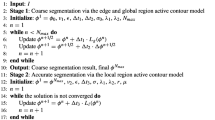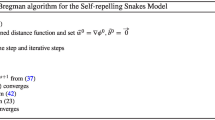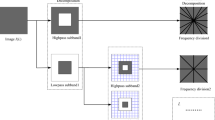Abstract
The active contour/snake model is one of the most successful variational models in image segmentation. It consists of evolving a contour in images toward the boundaries of objects. Its success is based on strong mathematical properties and efficient numerical schemes based on the level set method. The only drawback of this model is the existence of local minima in the active contour energy, which makes the initial guess critical to get satisfactory results. In this paper, we propose to solve this problem by determining a global minimum of the active contour model. Our approach is based on the unification of image segmentation and image denoising tasks into a global minimization framework. More precisely, we propose to unify three well-known image variational models, namely the snake model, the Rudin–Osher–Fatemi denoising model and the Mumford–Shah segmentation model. We will establish theorems with proofs to determine the existence of a global minimum of the active contour model. From a numerical point of view, we propose a new practical way to solve the active contour propagation problem toward object boundaries through a dual formulation of the minimization problem. The dual formulation, easy to implement, allows us a fast global minimization of the snake energy. It avoids the usual drawback in the level set approach that consists of initializing the active contour in a distance function and re-initializing it periodically during the evolution, which is time-consuming. We apply our segmentation algorithms on synthetic and real-world images, such as texture images and medical images, to emphasize the performances of our model compared with other segmentation models.
Similar content being viewed by others
References
Kass, M., Witkin, A., Terzopoulos, D.: Snakes: active contour models. Int. J. Comput. Vis. 1(14), 321–331 (1998)
Malladi, R., Kimmel, R., Adalsteinsson, D., Sapiro, G., Caselles, V., Sethian, J.: A geometric approach to segmentation and analysis of 3D medical images. In: Mathematical Methods, Biomedical Image Analysis Workshop (1996)
Yezzi, A., Kichenassamy, S., Kumar, A., Olver, P., Tannenbaum, A.: A geometric snake model for segmentation of medical imagery. IEEE Trans. Med. Imaging 16(2), 199–209 (1997)
Jonasson, L., Bresson, X., Hagmann, P., Cuisenaire, O., Meuli, R., Thiran, J.: White matter fiber tract segmentation in DT-MRI using geometric flows. Med. Image Anal. 9(3), 223–236 (2005)
Caselles, V., Kimmel, R., Sapiro, G.: Geodesic active contours. Int. J. Comput. Vis. 22(1), 61–79 (1997)
Kichenassamy, S., Kumar, A., Olver, P., Tannenbaum, A., Yezzi, A.: Conformal curvature flows: from phase transitions to active vision. Arch. Ration. Mech. Anal. 134, 275–301 (1996)
Crandall, M., Ishii, H., Lions, P.: Users’ guide to viscosity solutions of second order partial differential equations. Bull. Am. Math. Soc. 27(1), 1–69 (1992)
Osher, S., Sethian, J.: Fronts propagating with curvature-dependent speed: Algorithms based on Hamilton–Jacobi formulations. J. Comput. Phys. 79(1), 12–49 (1988)
Osher, S.: Level set methods. In: Osher, S., Paragios, N. (eds.) Geometric Level Set Methods in Imaging, Vision and Graphics, pp.3–20. Springer, New York (2003)
Sethian, J.: Level set methods and fast marching methods: evolving interfaces. In: Computational Geometry, Fluid Mechanics, Computer Vision and Material Sciences. Cambridge University Press, Cambridge (1999)
Osher, S., Fedkiw, R.: Level Set Methods and Dynamic Implicit Surfaces. Springer, New York (2003)
Jiang, G.-S., Peng, D.: Weighted ENO schemes for Hamilton–Jacobi equations. J. Sci. Comput. 21(6), 2126–2143 (1999)
Chan, T., Esedoḡlu, S., Nikolova, M.: Algorithms for finding global minimizers of image segmentation and denoising models, UCLA CAM Report 04-54 (2004)
Chan, T., Vese, L.: Active contours without edges. IEEE Trans. Image Process. 10(2), 266–277 (2001)
Rudin, L.I., Osher, S., Fatemi, E.: Nonlinear total variation based noise removal algorithms. Phys. D 60(1–4), 259–268 (1992)
Mumford, D., Shah, J.: Optimal approximations of piecewise smooth functions and associated variational problems. Commun. Pure Appl. Math. 42, 577–685 (1989)
Chan, T., Golub, G., Mulet, P.: A nonlinear primal-dual method for total variation-based image restoration. SIAM J. Sci. Comput. 20(6), 1964–1977 (1999)
Carter, J.: Dual methods for total variation-based image restoration. Ph.D. thesis, UCLA (2001)
Chambolle, A.: An algorithm for total variation minimization and applications. J. Math. Imaging Vis. 20(1–2), 89–97 (2004)
Aujol, J.-F., Chambolle, A.: Dual norms and image decomposition models. Int. J. Comput. Vis. 63(1), 85–104 (2005)
Aujol, J.-F., Gilboa, G., Chan, T., Osher, S.: Structure-texture image decomposition—modeling, algorithms, and parameter selection. Int. J. Comput. Vis. 67(1), 111–136 (2006)
Alliney, S.: Digital filters as absolute norm regularizers. IEEE Trans. Signal Process. 40(6), 1548–1562 (1992)
Alliney, S.: Recursive median filters of increasing order: a variational approach. IEEE Trans. Signal Process. 44(6), 1346–1354 (1996)
Alliney, S.: A property of the minimum vectors of a regularizing functional defined by means of the absolute norm. IEEE Trans. Signal Process. 45(4), 913–917 (1997)
Cheon, E., Paranjpye, A.: Noise removal by total variation minimization. UCLA MATH 199 project report, adviser. L. Vese (2002)
Nikolova, M.: Minimizers of cost-functions involving nonsmooth data-fidelity terms. SIAM J. Numer. Anal. 40(3), 965–994 (2002)
Alliney, S.: A variational approach to remove outliers and impulse noise. J. Math. Imaging Vis. 20(12), 99–120 (2004)
Alliney, S.: Weakly constrained minimization. Application to the estimation of images and signals involving constant regions. J. Math. Imaging Vis. 21(2), 155–175 (2004)
Chan, T., Esedoḡlu, S.: Aspects of total varation regularized L 1 function approximation. UCLA CAM Report 04-07 (2004)
Meyer, Y.: Oscillating patterns in image processing and in some nonlinear evolution equations. The Fifteenth Dean Jacquelines B. Lewis Memorial Lectures (2001)
Vese, L., Osher, S.: Modeling textures with total variation minimization and oscillating patterns. J. Sci. Comput. 19, 553–572 (2003)
Bresson, X., Esedoḡlu, S., Vandergheynst, P., Thiran, J.-P., Osher, S.: Global minimizers of the active Contour/Snake model. UCLA CAM Report 05-04 (2005)
Vese, L., Chan, T.: A multiphase level set framework for image segmentation using the Mumford and Shah model. Int. J. Comput. Vis. 50(3), 271–293 (2002)
Cohen, L., Bardinet, E., Ayache, N.: Surface reconstruction using active contour models. In: SPIE International Symposium on Optics, Imaging and Instrumentation (1993)
Cohen, L., Kimmel, R.: Global minimum for active contour models: A minimal path approach. Int. J. Comput. Vis. 24(1), 57–78 (1997)
Appleton, B., Talbot, H.: Globally optimal geodesic active contours. J. Math. Imaging Vis. 23(1), 67–86 (2005)
Strang, G.: L 1 and L ∞ approximation of vector fields in the plane. In: Nonlinear Partial Differential Equations in Applied Science, pp. 273–288. Kinokuniya, Tokyo (1982)
Strang, G.: Maximal flow through a domain. Math. Program. 26(2), 123–143 (1983)
Gomes, J., Faugeras, O.: Reconciling distance functions and level sets. J. Vis. Commun. Image Represent. 11, 209–223 (2000)
Leung, S., Osher, S.: Global minimization of the active contour model with TV-inpainting and two-phase denoising. In: Variational, Geometric, and Level Set Methods in Computer Vision (VLSM). Lecture Notes in Computer Science, vol. 3752, pp. 149–160. Springer, New York (2005)
Chambolle, A., Vore, R.D., Lee, N., Lucier, B.: Nonlinear wavelet image processing: Variational problems, compression, and noise removal through wavelet shrinkage. IEEE Trans. Image Process. 7(3), 319–335 (1998)
Author information
Authors and Affiliations
Corresponding author
Additional information
Research supported by NIH U54RR021813, NSF DMS-0312222, NSF ACI-0321917 and NSF DMI-0327077.
Rights and permissions
About this article
Cite this article
Bresson, X., Esedoḡlu, S., Vandergheynst, P. et al. Fast Global Minimization of the Active Contour/Snake Model. J Math Imaging Vis 28, 151–167 (2007). https://doi.org/10.1007/s10851-007-0002-0
Published:
Issue Date:
DOI: https://doi.org/10.1007/s10851-007-0002-0




